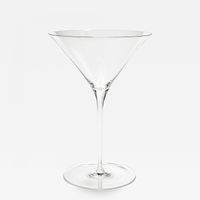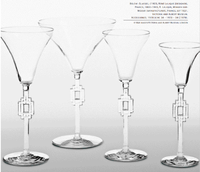Martini Glass: Difference between revisions
No edit summary |
No edit summary |
||
| Line 1: | Line 1: | ||
[[File:Martini-Glass-by-Oswald-Haerdtl.jpg|200px|thumb|right|Oswald Haerdtl Martini Glass from 1925]][[File:Rene_Lalique_1925_Paris_Exposition.png|200px|thumb|right|René Lalique Martini Glass from 1925]]Originally, cocktails didn't have a "dedicated" glass. Bartenders would use whatever glassware they felt was appropriate that they had on hand. It wouldn't be until the 1900's that a glass would emerge that would be seen to this day as the quintessential cocktail glass. Today we commonly call that a "Martini Glass" in honor of the drink that typically would have found it as its home. | [[File:Martini-Glass-by-Oswald-Haerdtl.jpg|200px|thumb|right|Oswald Haerdtl Martini Glass from 1925]][[File:Rene_Lalique_1925_Paris_Exposition.png|200px|thumb|right|René Lalique Martini Glass from 1925]]Originally, cocktails didn't have a "dedicated" glass. Bartenders would use whatever glassware they felt was appropriate that they had on hand. It wouldn't be until the 1900's that a glass would emerge that would be seen to this day as the quintessential cocktail glass. Today we commonly call that a "Martini Glass" in honor of the drink that typically would have found it as its home. | ||
It is difficult to find exactly when/where this glass first appeared, but there are a few rumors that point to the 1925 Paris Exposition as being the unveiling of the glass which would soon become a Martini Glass. A little searching shows two possible contenders, both in the classic Martini profile, and both from the 1925 Paris Exposition. One | It is difficult to find exactly when/where this glass first appeared, but there are a few rumors that point to the 1925 Paris Exposition as being the unveiling of the glass which would soon become a Martini Glass. A little searching shows two possible contenders, both in the classic Martini profile, and both from the 1925 Paris Exposition. One was produced by J. & L. Lobmeyr in collaboration with famed architect Oswald Haerdtl, which anybody would immediately recognize as an elegant, but standard, Martini glass. It was introduced as their "Ambassador" line, which is still in production to this day.<ref>[https://www.lobmeyr.at/produkte/1905/361 J. & L. Lobmeyr Ambassador glassware collection #240]</ref> The second is by René Lalique, which has a similar profile, but with a decidedly more "art deco" style. | ||
==References== | ==References== | ||
| Line 7: | Line 7: | ||
==External Links== | ==External Links== | ||
* [https://www.lobmeyr.at/produkte/1905/361 J. & L. Lobmeyr Ambassador glassware collection #240] | |||
* [https://www.incollect.com/listings/decorative-arts/tablewares/j-l-lobmeyr-ambassador-set-no-240-martini-glass-by-oswald-haerdtl-399306 "Ambassador" Oswald Haerdtl Martini Glass from 1925] (Oswald Haerdtl Martini glass from 1925 Paris Exposition) | * [https://www.incollect.com/listings/decorative-arts/tablewares/j-l-lobmeyr-ambassador-set-no-240-martini-glass-by-oswald-haerdtl-399306 "Ambassador" Oswald Haerdtl Martini Glass from 1925] (Oswald Haerdtl Martini glass from 1925 Paris Exposition) | ||
* [https://www.adeenidesigngroup.com/product/2217 "Ambassador" Set No. 240 Martini Glass by Oswald Haerdtl] (Adeeni Design Group) | |||
* [https://www.theage.com.au/multimedia/art_deco/pdf/Gill03.pdf Dreams Made Real] (René Lalique Martini glass from 1925 Paris Exposition) | * [https://www.theage.com.au/multimedia/art_deco/pdf/Gill03.pdf Dreams Made Real] (René Lalique Martini glass from 1925 Paris Exposition) | ||
* [https://sipsmith.com/the-history-of-the-martini-glass/ History of the Martini Glass] Jared Brown, Sipsmith | * [https://sipsmith.com/the-history-of-the-martini-glass/ History of the Martini Glass] Jared Brown, Sipsmith | ||
Revision as of 15:56, 8 January 2021
Originally, cocktails didn't have a "dedicated" glass. Bartenders would use whatever glassware they felt was appropriate that they had on hand. It wouldn't be until the 1900's that a glass would emerge that would be seen to this day as the quintessential cocktail glass. Today we commonly call that a "Martini Glass" in honor of the drink that typically would have found it as its home.
It is difficult to find exactly when/where this glass first appeared, but there are a few rumors that point to the 1925 Paris Exposition as being the unveiling of the glass which would soon become a Martini Glass. A little searching shows two possible contenders, both in the classic Martini profile, and both from the 1925 Paris Exposition. One was produced by J. & L. Lobmeyr in collaboration with famed architect Oswald Haerdtl, which anybody would immediately recognize as an elegant, but standard, Martini glass. It was introduced as their "Ambassador" line, which is still in production to this day.[1] The second is by René Lalique, which has a similar profile, but with a decidedly more "art deco" style.
References
External Links
- J. & L. Lobmeyr Ambassador glassware collection #240
- "Ambassador" Oswald Haerdtl Martini Glass from 1925 (Oswald Haerdtl Martini glass from 1925 Paris Exposition)
- "Ambassador" Set No. 240 Martini Glass by Oswald Haerdtl (Adeeni Design Group)
- Dreams Made Real (René Lalique Martini glass from 1925 Paris Exposition)
- History of the Martini Glass Jared Brown, Sipsmith

